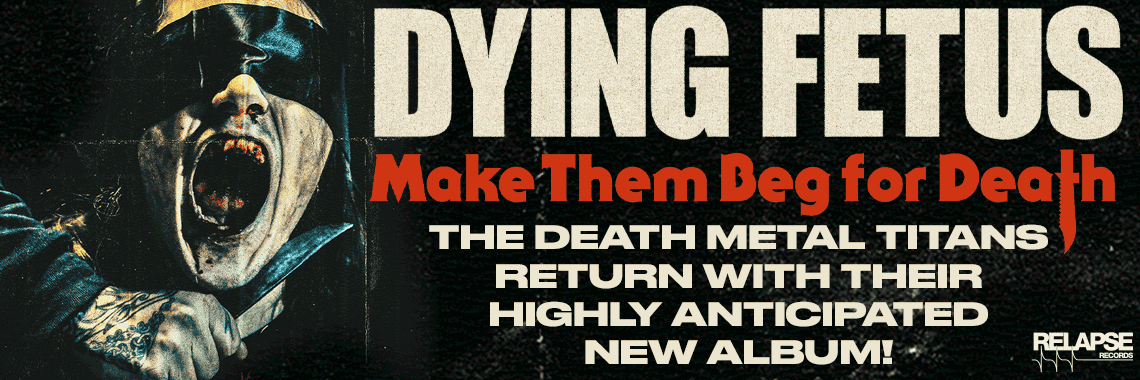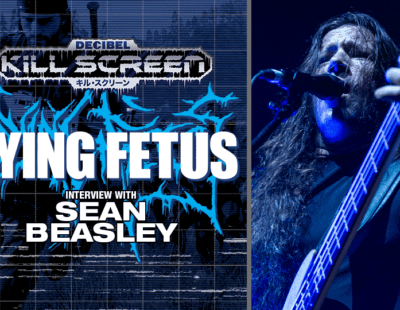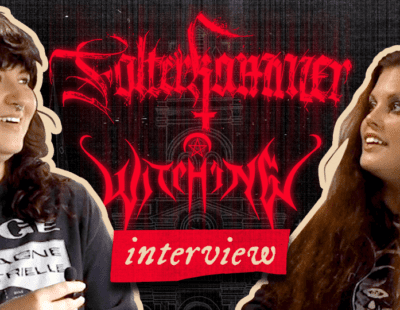
From the forest traipsing, stein swinging fervor of Korpiklaani and Finntroll to the somber nature worship of Agalloch and Panopticon, Decibel readers are undoubtedly familiar with the myriad forms that folk metal can take. The bands may have different styles, but the characteristics are usually the same: acoustic guitar passages, sing-along choruses, tons of beards, etc.
But every once in a while, a group comes along that puts a new spin on the genre and creates something truly captivating. Enter Nechochwen, a West Virginia-based duo that merges black metal with Native American instrumentation, artwork and lyrical themes. Their latest album, Heart of Akamon (released on Bindrune Recordings in early September), is a masterwork brimming with imaginative riffs; compelling atmosphere; and raw, impassioned melody. We spoke to Nechochwen’s eponymous guitarist/vocalist/songwriter about his musical process, artistic philosophy and deep ties to Native American culture.
Nechochwen’s music, lyrics and imagery are based on Native American history, specifically that of the Eastern Woodland Indians. Are all your themes focused on these tribes or is more of a general representation?
Our latest album, Heart Of Akamon, is a bit more region-specific than some of our other releases. It focuses predominantly on the Eastern United States, but most of the themes could apply in other areas, too. In other words, similar things could have happened in other times and places—and in many cases, they actually did—but the details mainly concern Eastern tribes like the Shawnee and Seneca because that’s what I’m most familiar with and knowledgable about. I have Shawnee ancestry, so it’s what I write about. It’s a way to honor my personal connection [to that culture].
Having one project that’s a general representation of American Indian history is beyond my abilities, as would a band about Asian or African history in general. That’s too vast for me and sounds artistically stressful. A friend told me he was going to attempt it and I said, “Good luck with that!” We’ve had songs inspired by people and events from distant places. “At Night May I Roam” is an English translation of a Lakota poem. “Traversing the Shades of Death” is about the white settlers of the Wyoming Valley in Pennsylvania. “Winterstrife” is about an unemployed single father raising children during the Great Depression. Most of our songs have Eastern Woodland themes or universal themes of nature.
I feel that Woodland Indian culture is vastly underrepresented, misunderstood, and brushed aside in our culture and world culture. We all learned about Sitting Bull, Seattle, Chief Joseph and Geronimo in school, and that’s wonderful, but even here in West Virginia, I learned about Tecumseh, Brant, Black Hawk and Half King on my own, not from school or movies. I want to shine a light on the amazing things we never seem to hear about. This is just part of our focus. The original intent of Nechochwen was to connect to people who know things that aren’t found in books or online. I knew of no better way to reach out to people than to just be honest and put myself out there to receptive people whom I might learn from. I’m thankful that Pohonasin [drums, bass] joined me and has been helping me tremendously in this effort, and that many incredible people have, in fact, reached out to us.
Heart of Akamon was recorded between June 2013 and March 2015. Did you intend for the recording process to take that long to complete? Was there a moment when you realized the album needed more time to grow and develop, or was it more of a logistical decision?
We decided from the outset to approach this album differently. Bindrune Recordings set no deadline for us and gives its artists complete artistic and creative freedom, so there was no pressure to rush things. Basically, we vowed to not settle for an album that was anything other than the exact music that we personally want to listen to, regardless of who made it and how long it took. There were things going on in our personal lives that caused delays, but that also made the making of the album a cathartic thing rather than a source of stress.
We took some time off here and there to work on projects by Unwilling Flesh, End and Coldfells, and we took a break to put together a live show. Each time was just enough time to let each song “ferment” for a while, but not so much time that we lost interest or cohesiveness. The live show preparations and vocal contributions to Coldfells, End, and Obsequiae made me step up my vocal practice and boosted my confidence. I’m indebted to these projects; they absolutely benefited this album and I think we took the perfect amount of time to make it.
What does the Nechochwen writing process look like?
The ideas for Nechochwen’s music fall into two categories. One is riffs and lyrics that arise spontaneously and are well-developed and catalogued on paper or demoed in my basement. I give these ideas a name that I write on a card so I can “hold the riff” in my hand later and make it a concrete thing that I can see being useful with other riffs. It’s like planting a garden or building an addition on your house—you piece these blocks together. These are more traditional “songs” in my view. We took this approach with “The Serpent Tradition,” “Lost on the Trail of the Setting Sun” and “October 6, 1813.”
The other category is what I think of as “composed” music. These are almost always from a classical guitar, an acoustic guitar or a piano. They aren’t really riffs; they’re a series of arpeggios that form a skeletal framework. A lot of our first two albums are these kinds of ideas by themselves, like “Fallen Timbers,” “Weeping Eye” and the first half of “Red Ocher.” If you really want to pick apart what we’re doing musically on our more recent songs, we often have an arpeggiated acoustic guitar part as the skeleton with a metal skin over it. “Traversing the Shades of Death” is a perfect example of this. There’s an acoustic part going on under the whole thing the entire time.
“October 6, 1813” is about the day after the Battle of the Thames. What’s the lyrical and musical significance of this song for you?
With all the war and aggression of “The Serpent Tradition” and “Lost on the Trail of the Setting Sun,” by the fourth song, the album needed some balance. I wanted to write a lament…a true lament rather than a eulogy or a complaint—a picture of the sadness of the burial of a powerful, irreplaceable man. Tecumseh was a great man whom I have always admired and revered. I’m a bit embarrassed that it’s taken so many years for me to write a lament for him. I wasn’t there, of course, as it happened 202 years ago, so I had to take all of my sources on [the event] and just follow my heart and gut. I wrote the lyrics in reaction to the accounts given by author Allan W. Eckert and others. I wanted to paint a musical picture of the sadness of not only losing a leader, friend and chief, but also the collapse of hope because Tecumseh was the leader of the largest confederation of Indian tribes in history. His death signaled the death of the hope of driving the Americans back over the Atlantic.
Do you remember the first time you learned about the Battle of the Thames?
I first became fascinated with this battle and many others in Shawnee history when I was 13 years old. It took 24 years for it to feel proper to make a song about it, but I definitely started feeling a very strong urge to write a song like this during this album cycle.
Is there a thematic thread that ties all the songs on Heart of Akamon together, or do you see them existing as separate stories?
First, let me explain what the title means to us, as it may help to answer the question. “Akamon” is a very old word; so old that we’re not sure if it’s Hitchiti or Yuchi, probably pre-dating the Shawnee and Lenape languages. It’s been a part of the lexicon of the local Native people I’ve known for many years now; people of Shawnee, Lenape, Cherokee and Seneca ancestry. I don’t know very many of these old words and I wish I knew more. “Aka” by itself means first. “Akamon” means wilderness, as in Earth in her primal form. What we are saying with the title is “Heart of the Wilderness”—this ancient, primal wilderness where we live that you still see glimpses of here and ther even in modern times.
The songs mostly represent the transition from primal wilderness to modern, developed North America, but some of the songs are about ancient tradition/lore and giving thanks. They are their own, separate song themes, but they all have their own connection to the primal wilderness. We didn’t have a grand design or anything for this album, and it started out as a completely scattered, directionless pile of thoughts. That’s really what took us so long: that fermentation process to make sure the ideas flow together well. The end result is just a collection of things we’ve been thinking about over the last couple of years.
You’re a prolific acoustic musician and incorporate a lot of acoustic elements into Nechochwen’s music. Do you write every Nechochwen riff on acoustic guitar?
Years ago, I did write all the riffs on an acoustic or classical guitar. Often, this was the way things stayed on our albums. That’s why Algonkian Mythos, Azimuths To The Otherworld and Oto have so many acoustic parts. You see, I spend a lot of time in studio offices teaching guitar and other instruments. There have always been gaps in my day where students have to cancel or don’t show up or whatever, and I use this time to practice or learn pieces for the solo gigs I play (classical recitals, weddings, clubs, whatever). These are always classical or acoustic things. I get ideas spontaneously and the first thing I see in front of me is an acoustic guitar, so that’s what I work the ideas out with. Sometimes I go over to the piano in my office and mess around with ideas on that; there’s a very old Steinway in there that sounds really good.
For Heart of Akamon, I decided to try some new things. I bought the first floating tremolo guitar I’ve had in 25 years. I used to hate them but I decided to try again with a Schecter. That’s the one you hear in the solo on “The Serpent Tradition.” The first things I played on it were the riffs from “Lost on the Trail of the Setting Sun” and “Skyhook.” Those riffs just came out instantly and I bought the guitar without a second thought.
I also bought a Schecter 8-string that has solved the intonation issues we’ve had in the past and extended the range of our riffs much lower. A lot of the riffs and harmonies [on Heart of Akamon] were written and performed on this guitar. Since it seems like I’m always busy doing something these days, I have a lot of riffs that I write in my head and then record them on whatever guitar is most appropriate.
What’s your general philosophy when it comes to the inclusion of acoustic instrumentation in extreme metal?
My philosophy is to do whatever works best. Early Ulver and Abigor albums were an enormous influence on us, along with early Opeth and Anathema, so maybe these are still rubbing off on us in the unique way they used acoustic guitars. Nowadays, I just enjoy making this music, and the best thing is to just let it become exactly what it should become. I don’t care about categories or genres, and I think people are way too hung up on that in general. I like doing things with music that make people a bit uncomfortable, but in this case I don’t know why it would. I think the very best albums have a good variety of styles and dynamics. The acoustic guitar (while admittedly not super effective for a lo-fi black metal or war metal band) is very effective in creating variety and dynamics in the music we make. Just do what works best and don’t think about it very much, but think about it from time to time. Then let it sit for two and a half years before you finish it and release it. That’s my philosophy. At least this year it is…we’ll probably do something completely different next time!
One of Heart of Akamon‘s most effective attributes is the powerful, stirring clean vocals. Do you base your vocal melodies on traditional Native American songs, or do you just try to emulate that style through your own melodic sensibilities?
In most cases, it’s the latter. I work out the ideas in my car when driving from place to place. We make demos/rough song mixes at the studio and then I sing along to them. I try to come up with lyrics and vocal harmonies that way. I almost exclusively work like this. Ninety percent of the time, Pohonasin comes up with a better vocal rhythm/cadence for me to sing when we get in the studio. I had some Native vocal influence for the backing vocals on “October 6, 1813” and “Škimota,” and parts of some past songs like “Heya Hona,” “Allumhammochwen: The Crossing,” “Talgayeeta” and the traditional Shawnee song, “Pilawah.”
Do you think Nechochwen will ever be a live band, or do you consider it a studio-only project?
I take it as a huge compliment that we get asked this question quite often by friends, fans and interviewers. People must be endlessly frustrated with us! We played for the first time as a group in late 2014 at Hammerheart Brewing Company’s Winterblot Fest. Other than that, I’ve only done a couple of solo Nechochwen appearances. Neither I nor Pohonasin ever intended to make this a live project, but we both understand the importance of interacting with fans and that a lot of people would enjoy seeing this music played on stage.
Pohonasin has another band called Brimstone Coven that plays live quite often, so he’s much more seasoned at playing live with bands than I am. I’m used to mellow solo gigs where I have to wear a suit while people drink champagne…it’s been a part of my career path and I haven’t even done much of that lately! So, getting ready for live gigs is a big deal for me. Nechochwen’s music is very layered and it has to be adapted a bit for the stage. My brain is wired to hear things in an orchestrated way like when we are recording. Pandel Collaros and Amanda McCoy are experts at arranging recorded music for the stage and have really helped us. Now we need to have some of our newer, heavier material performed live. It’s something we hope to do at some point here and there, but I don’t ever see us touring.
What’s your musical relationship with Pohonasin like? How does he fit into the Nechochwen collaboration process?
We started collaborating in 2002 in the band Harvist, and he has been the easiest and most natural person to work with I’ve ever met. Many others would tell you the same thing. The elements he brings to Nechochwen, Brimstone Coven, Obsequiae and many others is remarkable. At first, his role in Nechochwen was to bring out the best tones, enhance the ideas I had and build off of the musical chemistry we’ve been working on for 13 years now. This is still the case, but now he plays more of a role in improving the lyrics (one of his best talents) and vocal harmonies. And both his drumming and bass playing have continued to get better and better. I really enjoy his artistry and hearing how his skills and instincts have developed.
Oh yeah, I should probably mention that Pohonasin painstakingly produces, records, mixes, masters and does the album layout for Nechochwen. We should probably change the name of this band to Pohonasin.
Nechochwen’s new LP, Heart of Akamon, is available to stream and purchase here.







